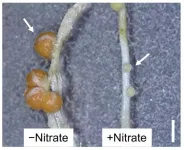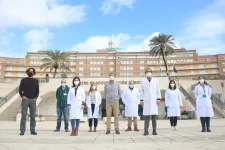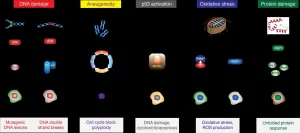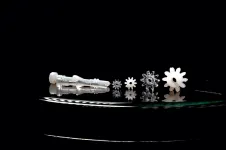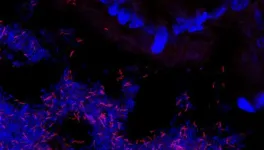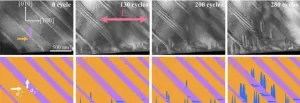Abrupt ice age climate changes behaved like cascading dominoes
2021-04-09
(Press-News.org) Throughout the last ice age, the climate changed repeatedly and rapidly during so-called Dansgaard-Oeschger events, where Greenland temperatures rose between 5 and 16 degrees Celsius in decades. When certain parts of the climate system changed, other parts of the climate system followed like a series of dominos toppling in succession. This is the conclusion from an analysis of ice-core data by a group of researchers that included postdoc Emilie Capron and associate professor Sune Olander Rasmussen from the Section for the Physics of Ice, Climate and Earth at the Niels Bohr Institute, University of Copenhagen, in Denmark. This discovery, just published in the journal Nature Communications, is concerning because the extent of sea ice in the Arctic played an important part in these dramatic climate shifts of the past. Today, sea-ice extent is being rapidly reduced, and it is uncertain whether this part of the climate system can trigger sudden future climate change.
Understanding abrupt climate changes in the past is critical to our ability to confidently predict whether something similar will occur today or in the near future.
Over the last several decades, this has led climate scientists to search for causal relationships of abrupt climate change during the ice age when Greenland temperatures repeatedly rose by as much as 16 degrees Celsius in just decades before slowly falling back to normal ice-age levels.
The question
"Many studies have tried to answer this long-standing question: Which part of the climate system changed first when these approximately 30 abrupt climate changes, called Dansgaard-Oeschger events, began? Was it, for example, the ocean currents in the North Atlantic, the wind and rainfall patterns in the Northern Hemisphere, or the spread of sea ice in the Arctic that triggered climate change?" says ice-core scientist Emilie Capron from the Niels Bohr Institute (University of Copenhagen) and the Institute of Environmental Geosciences (CNRS/Université Grenoble Alpes/IRD/Grenoble INP), who led the study now published in Nature Communications.
This new analysis reveals a surprisingly diverse set of dynamics within the Dansgaard-Oeschger events. The same physical processes changed together like a row of cascading dominoes, but surprisingly, neither the rate of change nor the order of the processes were the same from one event to the other.
In search of an explanation
The team of researchers used data from two parallel Greenland ice cores that spanned the last ice age to create an image of a typical Dansgaard-Oeschger event and to determine in what order the parts of the climate system changed at the onset of the abrupt climate transitions.
The goal is to be able to transfer this knowledge of the past to today's climate and use the fingerprint of past climate change as a kind of warning signal for possible abrupt climate changes in the future.
The analysis, funded by the EU as a Marie Sk?odowska-Curie Action and from a research grant from the Carlsberg Foundation, showed that changes in different parts of the climate system - ocean currents, sea-ice and wind patterns - were so closely intertwined that they likely triggered and reinforced each other, and led to these reoccurring abrupt climate changes.
Confirmed by a model
The results led the international team of scientists to compare the ice-core data with new results from climate model simulations of the last ice age developed by co-author Guido Vettoretti, postdoc at the Niels Bohr Institute. This IPCC-class of climate model is the same type as those used to make projections of future climate change. The comparison revealed that the model showed the same type of entangled behaviour of sea ice, strength of ocean currents, and wind and precipitation patterns.
This is positive news in that it increases our confidence that these complex models demonstrably capture the physical processes needed to simulate these past abrupt climate changes. However, the result is also worrisome: One of the climate dominoes that could disrupt the entire system during the ice age was the extent of sea-ice cover in the North Atlantic, and the modern extent of sea ice has been declining at a significant rate since the 1980s, highlighting the risk of a similar domino effect due to man-made climate change.
Implications for future climate
Unfortunately, our understanding of the interplay between the many parts of the Earth's climate system is insufficient to allow us to assess the risk of similar occurrences of abrupt climate change in the future.
Likewise, following the domino analogy: We do not know to what extent the initial conditions of the dominoes are different in today's climate system compared to the situation during the last ice age.
"In any case, the results emphasize the importance of trying to limit climate change by, for example, cutting anthropogenic emissions of CO2 and other greenhouse gases, both to reduce the predictable, gradual climate change and to reduce the risk of future abrupt climate change," says co-author Sune Olander Rasmussen, associate professor at the Niels Bohr Institute, and adds: "If you do not want the dominoes to topple over, you are better off not to push the table they stand on too much."
INFORMATION:
[Attachments] See images for this press release:
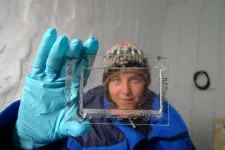
ELSE PRESS RELEASES FROM THIS DATE:
2021-04-09
Tsukuba, Japan - Plants in the bean family (legumes) form nodules on their roots to take up nitrogen. Legumes will stop nodule production when nitrogen is plentiful (Figure 1), but precisely how nitrate presence controls nodule formation in these plants has been a mystery. Now, researchers from Japan have found that interactions between proteins and nitrate can induce and repress genes, controlling nodulation with potential applications in sustainable agriculture.
In a study published in April in The Plant Cell, a research team from the University of Tsukuba has shown that the different DNA-binding properties between proteins that establish nodule development determine if genes involved in symbiosis that govern nodulation turn on or off and that ...
2021-04-09
Two studies led by the Mental Health Unit of the Virgen del Rocio University Hospital and involving researchers from the US conclude that antipsychotic drugs could have a protective effect against SARS-CoV-2. For this reason, patients treated with these drugs have a lower risk of becoming infected or suffer a milder form of the disease if they do become infected.
Thus, a first descriptive epidemiological study of a sample of 698 patients treated with antipsychotics at the Seville hospital revealed that antipsychotic drugs could provide protection against both infection and the tendency to clinical severity of Covid-19 infection. "These are very interesting findings that reflect a clinical reality where we see few patients ...
2021-04-09
Since the beginning of the coronavirus pandemic, scientists and physicians worldwide undertook enormous efforts to understand the disease caused by the virus. In their latest collaborative study, researchers from the Max Planck Institute of Immunobiology and Epigenetics in Freiburg and physicians from the University of Freiburg Medical Center unveil a novel feature of COVID-19 immunity, which could have implications for future therapies. The study points to the involvement of Interleukin 33, an important danger signal, when immune cells encounter Sars-CoV-2 for a ...
2021-04-09
An international group of scientists led by the RIKEN Cluster for Pioneering Research have studied the chemical composition of 50 protoplanetary-disk forming regions in the Perseus Molecular Cloud, and found that despite being in the same cloud, the amounts of complex organic molecules they contain are quite different. Interestingly, the chemically rich young disks have similar compositions of organic molecules. These findings raise an important question: do solar-like systems share a common chemistry at birth?
It was once believed that complex organic molecules were rare in the universe, and that this rarity ...
2021-04-09
Imperial Brands scientists have utilised Toxys' ToxTracker suite of stem-cell based in-vitro assays, which provide mechanistic insight into the potential DNA damaging properties of chemicals, comparing vape e-liquid samples and their aerosols to combustible cigarette smoke.
Imperial scientists are the first to publish results using the ToxTracker system for the assessment of vape e-liquids and aerosols, and it forms part of the company's continuing research into the tobacco harm reduction potential of Next Generation Products (NGPs) such as vapes.
The assays help assess how product samples may impact cellular functioning across six reporter cell lines, picking up the tell-tale molecular signs of potential harm in the ...
2021-04-09
Glass is ubiquitous, from high-tech products in the fields of optics, telecommunications, chemistry and medicine to everyday objects such as bottles and windows. However, shaping glass is mainly based on processes such as melting, grinding or etching. These processes are decades old, technologically demanding, energy-intensive and severely limited in terms of the shapes that can be realized. For the first time, a team led by Prof. Dr. Bastian E. Rapp from the Laboratory of Process Technology at the Department of Microsystems Engineering at the University of Freiburg, in collaboration with the Freiburg-based start-up Glassomer, has developed a process that makes it possible to form glass easily, quickly and in almost any shape using injection ...
2021-04-09
The unpopular guests are already here. Hazel-, alder- and elm tree pollen sweep in over us during the early spring months, with birch pollen following in May. Then grass follows in June-July before mugwort pollen closes the season in late summer. All leading to more and more people suffering.
Over fifty years, the proportion of young Danes who sneeze, rub itchy eyes or suffer a blocked nose because of pollen has grown from 7-8 per cent in the 1970s to 24 per cent today. And for asthma, the proportion has risen from 4 to 12 per cent during the same period. ...
2021-04-09
Diet and the gut microbiome
With the consumption of a single type of vegetable such as spinach, hundreds of chemical components enter our digestive tract. There, they are further metabolized by the gut microbiome, a unique collection of hundreds of microbial species. The gut microbiome thus plays a major role in determining how nutrition affects our health. "So far, however, the metabolic capabilities of many of these microorganisms in the microbiome are still unknown. That means we don't know what substances they feed on and how they process them," explains ...
2021-04-09
Researchers at Lund University in Sweden have discovered that bird blood produces more heat in winter, when it is colder, than in autumn. The study is published in The FASEB Journal.
The secret lies in the energy factories of cells, the mitochondria. Mammals have no mitochondria in their red blood cells, but birds do, and according to the research team from Lund and Glasgow this means that the blood can function as a central heating system when it is cold.
"In winter, the mitochondria seem to prioritize producing more heat instead of more energy. The blood becomes a type of radiator that they can turn up when it gets colder", says Andreas Nord, researcher in evolutionary ecology at Lund University who led the study.
Until ...
2021-04-09
Ferroelectric materials are used in many devices, including memories, capacitors, actuators and sensors. These devices are commonly used in both consumer and industrial instruments, such as computers, medical ultrasound equipment and underwater sonars.
Over time, ferroelectric materials are subjected to repeated mechanical and electrical loading, leading to a progressive decrease in their functionality, ultimately resulting in failure. This process is referred to as 'ferroelectric fatigue'.
It is a main cause of the failure of a range of electronic devices, with discarded electronics a leading contributor to e-waste. Globally, tens of millions of tonnes of failed electronic devices go to landfill every year.
Using advanced ...
LAST 30 PRESS RELEASES:
[Press-News.org] Abrupt ice age climate changes behaved like cascading dominoes

